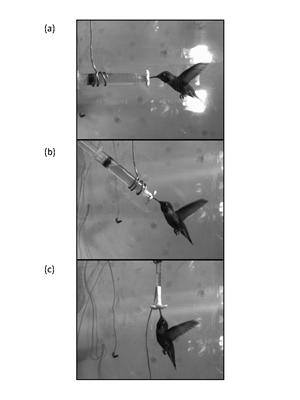Nov 22 2012
How flowers have evolved particular colours, shapes and scents to attract pollinators has long fascinated ecologists. Now, using artificial flowers and high-speed video, researchers have gained intriguing insights into the intimate relationship between hummingbirds and the flowers they pollinate. The study, published in the British Ecological Society's journal Functional Ecology, is the first to measure how much energy hummingbirds use while hovering to feed from flowers of different orientation.
 Body posture of an Anna’s Hummingbird when feeding from horizontal (a), tilted (b), and vertical (c) feeders. Copyright Nir Sapir.
Body posture of an Anna’s Hummingbird when feeding from horizontal (a), tilted (b), and vertical (c) feeders. Copyright Nir Sapir.
Hummingbirds are among the smallest and most brightly-coloured birds on Earth, and one of the only types of bird capable of hovering for long periods. They are also crucial pollinators of flowering plants across the Americas. Hummingbird-pollinated flowers are usually red, tubular-shaped and have no smell, characteristics that have been well-studied by ecologists. Why most hummingbird-pollinated flowers hang down vertically, however, has remained a mystery.
Working with Anna's hummingbirds (Calypte anna) – the most common hummingbird species on their university campus – Dr Nir Sapir and Dr Robert Dudley of the University of California, Berkeley built a series of artificial “flowers”. The artificial flowers, which pointed horizontally, vertically-downwards or were tilted 45 degrees downward, supplied nectar to the birds.
After training the hummingbirds to feed from the artificial flowers, the researchers used high-speed video to record how flower orientation affected the birds' body position and hovering style while feeding. They then fitted the artificial flowers with a mask to measure the amount of oxygen – and hence how much energy – the birds used to hover while feeding.
The results revealed that to feed from flowers hanging down vertically, the hummingbirds had to adopt a “bizarre” body position, with their bodies upright and heads bent back, and that doing so required 10% more energy than feeding from horizontal flowers.
The results are intriguing, says Dr Sapir: “Because flowers need pollinators to reproduce, flowers have evolved to attract pollinators. Almost all hummingbird-pollinated flowers hang down vertically, so our hypothesis was that they evolved this way because hummingbirds would have to use less energy to feed from them. We found the opposite – that it's more costly in energy terms for hummingbirds to feed from these flowers.”
In evolutionary terms, this means other factors must be at play. “Our findings suggest other factors may be dictating flower orientation. Flowers may need to exclude less efficient pollinators, such as insects, and so flowers that hang down vertically may be selected during evolution to increase pollination efficiency. And horizontal flowers are more exposed to rain, which can dilute the amount of nectar in a flower, and we know that hummingbirds can tell how sweet nectar is, so they may select downward-facing flowers because their nectar is less diluted by rain and thus contains the most sugar.”
Nir Sapir and Robert Dudley (2012). 'Implications of floral orientation for flight kinematics and metabolic expenditure of hover-feeding hummingbirds', doi: 10.1111/1365-2435.12024, is published in Functional Ecology on Wednesday 21 November 2012.